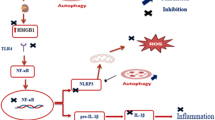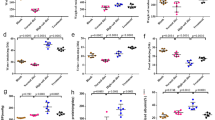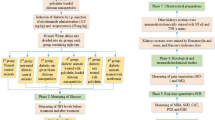Abstract
Diabetic nephropathy (DN) as one of the common microvascular complications of diabetes mellitus, is the main cause of end-stage renal disease. Zinc oxide nanoparticles (ZnO NPs) have been employed in several biomedical aspects. This study purposed to explore the mechanistic renoprotective effects of ZnO NPs in STZ-induced DN. Sixty male Wistar rats were allocated into four equal groups: control, ZnO NPs control, STZ, and STZ + ZnO NPs groups. At the end of the experiment, blood and urine biochemical parameters were assayed. Renal tissue level of advanced glycation end products (AGEs) was assayed spectrofluorometrically, moreover, nuclear factor erythroid 2–related factor 2 (Nrf2) DNA-binding activity and IL-1β levels were detected by ELISA. The gene expression levels of thioredoxin-interacting protein (TXNIP) and NOD-like receptor family pyrin domain containing 3 (NLRP3) were detected by quantitative real-time PCR. Oxidative stress markers were determined spectrophotometrically. Also, renal tissue histopathological and immunohistochemical analyses were determined. After 6 weeks of treatment, ZnO NPs markedly improved the biochemical, renal functions, and histopathological findings. Furthermore, ZnO NPs significantly increased Nrf2-DNA-binding activity and downregulated TXNIP gene expression leading to restoration of the redox status. Additionally, ZnO NPs ameliorated AGEs levels, enhanced autophagy activity, and attenuated inflammasome activation via downregulation of NLRP3 expression and reducing IL-1β levels. Based on our results, we concluded that ZnO NPs can be considered as a promising agent for slowing the progression of DN via interplay between autophagy and Nrf2/TXNIP/NLRP3 inflammasome signaling.






Similar content being viewed by others
Data Availability
The datasets used and/or analyzed during the current study are available from the corresponding author on reasonable request.
Abbreviations
- DN:
-
Diabetic nephropathy
- Nrf2:
-
Nuclear factor erythroid 2–related factor 2
- TXNIP:
-
Thioredoxin-interacting protein
- NLRP3:
-
NOD-like receptor family pyrin domain containing 3
- ROS:
-
Reactive oxygen species
- ZnO NPs:
-
Zinc oxide nanoparticles
- STZ:
-
Streptozotocin
- FBG:
-
Fasting blood glucose
- AGEs:
-
Advanced glycation end products
- MDA:
-
Malondialdehyde
- SOD:
-
Superoxide dismutase
- ARE:
-
Antioxidant response element
References
Ding T, Wang S, Zhang X, Zai W, Fan J, Chen W, Bian Q, Luan J, Shen Y, Zhang Y, Ju D (2018) Kidney protection effects of dihydroquercetin on diabetic nephropathy through suppressing ROS and NLRP3 inflammasome. Phytomedicine 41:45–53
Zheng S, Powell DW, Zheng F, Kantharidis P. & Gnudi L. (2016) Diabetic nephropathy: proteinuria, inflammation, and fibrosis. J Diabetes Res, Article ID 5241549, 2 pages, 2016. https://doi.org/10.1155/2016/5241549
Matzinger M, Fischhuber K, Heiss EH (2018) Activation of Nrf2 signaling by natural products-can it alleviate diabetes? Biotechnol Adv 36(6):1738–1767
Hennig P, Garstkiewicz M, Grossi S, Di Filippo M, French LE, Beer HD (2018) The crosstalk between Nrf2 and inflammasomes. Int J Mol Sci 19(2):562
Chen J, Jing G, Xu G, Shalev A (2014) Thioredoxin-interacting protein stimulates its own expression via a positive feedback loop. Mol Endocrinol 28(5):674–680
Lu M, Yin N, Liu W, Cui X, Chen S, Wang E. (2017) Curcumin ameliorates diabetic nephropathy by suppressing NLRP3 inflammasome signaling. BioMed Res Int 2017
Hutton HL, Ooi JD, Holdsworth SR, Kitching AR (2016) The NLRP3 inflammasome in kidney disease and autoimmunity. Nephrology 21(9):736–744
Smijs TG, Pavel S (2011) Titanium dioxide and zinc oxide nanoparticles in sunscreens: focus on their safety and effectiveness. Nanotechnol Sci Appl 4:95
Jiang J, Pi J, Cai J. (2018) The advancing of zinc oxide nanoparticles for biomedical applications. Bioinorg Chem Appl 2018
Yue T, Xu HL, Chen PP et al (2017) Combination of coenzyme Q10-loaded liposomes with ultrasound targeted microbubbles destruction (UTMD) for early theranostics of diabetic nephropathy. Int J Pharm 528(1–2):664–674
Bashandy SA, Alaamer A, Moussa SA, Omara EA (2018) Role of zinc oxide nanoparticles in alleviating hepatic fibrosis and nephrotoxicity induced by thioacetamide in rats. Can J Physiol Pharmacol 96(4):337–344
Takahashi S, Takahashi I, Sato H, Kubota Y, Yoshida S, Muramatsu Y (2000) Determination of major and trace elements in the liver of Wistar rats by inductively coupled plasma-atomic emission spectrometry and mass spectrometry. Lab Anim 34(1):97–105
Bazzano T, Restel TI, Porfirio LC, Souza AS, Silva IS (2015) Renal biomarkers of male and female Wistar rats (Rattus norvegicus) undergoing renal ischemia and reperfusion. Acta cirurgica brasileira 30(4):277–288
Sensi M, Pricci F, Pugliese G, De Rossi MG, Petrucci AF, Cristina A, Morano S, Pozzessere G, Valle E, Andreani D, Di Mario U (1995) Role of advanced glycation end-products (AGE) in late diabetic complications. Diabetes Res Clin Pract 28(1):9–17
DiMagno MJ (2007) Nitric oxide pathways and evidence-based perturbations in acute pancreatitis. Pancreatology 7(5–6):403–408
Drury RA, Wallington EA (1980) Carleton’s histological technique, 5th edn. Oxford University Press, New York
Davies, H. and Crombie, L. (2009): What are confidence intervals and p-values?, Second edition, Hayward \group Ltd., P 1–6
Duran-Salgado MB, Rubio-Guerra AF (2014) Diabetic nephropathy and inflammation. World J Diabetes 5:393–398
Qiao Y, Gao K, Wang Y, Wang X, Cui BO (2017) Resveratrol ameliorates diabetic nephropathy in rats through negative regulation of the p38 MAPK/TGF-β1 pathway. Exp Ther Med 13(6):3223–3230
Umrani RD, Paknikar KM (2014) Zinc oxide nanoparticles show antidiabetic activity in streptozotocin-induced type 1 and 2 diabetic rats. Nanomedicine 9(1):89–104
Ashraf JM, Ansari MA, Fatma S, Abdullah SM, Iqbal J, Madkhali A, Hamali AH, Ahmad S, Jerah A, Echeverria V, Barreto GE (2018) Inhibiting effect of zinc oxide nanoparticles on advanced glycation products and oxidative modifications: a potential tool to counteract oxidative stress in neurodegenerative diseases. Mol Neurobiol 55(9):7438–7452
Jia J, Wang Z, Yue T, Su G, Teng C & Yan B. (2020) Crossing biological barriers by engineered nanoparticles. Chem Res Toxicol
Duran-Salgado MB, Rubio-Guerra AF (2014) Diabetic nephropathy and inflammation. World J Diabetes 5(3):393
Aitken RJ, Roman SD (2008) Antioxidant systems and oxidative stress in the testes. Oxid Med Cell Longev 1(1):15–24
Nguyen T, Nioi P, Pickett CB (2009) The Nrf2-antioxidant response element signaling pathway and its activation by oxidative stress. J Biol Chem 284(20):13291–13295
Manna K, Mishra S, Saha M, Mahapatra S, Saha C, Yenge G, Gaikwad N, Pal R, Oulkar D, Banerjee K, Saha KD (2019) Amelioration of diabetic nephropathy using pomegranate peel extract-stabilized gold nanoparticles: assessment of nf-κb and nrf2 signaling system. Int J Nanomed 14:1753
Li J, Chen H, Wang B, Cai C, Yang X, Chai Z, Feng W (2017) ZnO nanoparticles act as supportive therapy in DSS-induced ulcerative colitis in mice by maintaining gut homeostasis and activating Nrf2 signaling. Sci Rep 7(1):1–1
Feng H, Gu J, Gou F, Huang W, Gao C, Chen G, Long Y, Zhou X, Yang M, Liu S, Lü S. (2016) High glucose and lipopolysaccharide prime NLRP3 inflammasome via ROS/TXNIP pathway in mesangial cells. J Diabetes Res 2016
He X, Ma Q (2012) Redox regulation by nuclear factor erythroid 2-related factor 2: gatekeeping for the basal and diabetes-induced expression of thioredoxin-interacting protein. Mol Pharmacol 82(5):887–897
Yin Y, Chen F, Wang W, Wang H, Zhang X (2017) Resolvin D1 inhibits inflammatory response in STZ-induced diabetic retinopathy rats: possible involvement of NLRP3 inflammasome and NF-κB signaling pathway. Mol Vis 23:242
Zhang L, Chu W, Zheng L, Li J, Ren Y, Xue L, Duan W, Wang Q, Li H. (2020) Zinc oxide nanoparticles from Cyperus rotundus attenuates diabetic retinopathy by inhibiting NLRP3 inflammasome activation in STZ-induced diabetic rats. J Biochem Mol Toxicol e22583
Zhou R, Tardivel A, Thorens B, Choi I, Tschopp J (2010) Thioredoxin-interacting protein links oxidative stress to inflammasome activation. Nat Immunol 11(2):136–140
Jiang XS, Xiang XY, Chen XM, He JL, Liu T, Gan H, Du XG (2020) Inhibition of soluble epoxide hydrolase attenuates renal tubular mitochondrial dysfunction and ER stress by restoring autophagic flux in diabetic nephropathy. Cell Death Dis 11(5):1–8
Roy R, Singh SK, Chauhan LK, Das M, Tripathi A, Dwivedi PD (2014) Zinc oxide nanoparticles induce apoptosis by enhancement of autophagy via PI3K/Akt/mTOR inhibition. Toxicol Lett 227(1):29–40
Sureshbabu A, Ryter SW, Choi ME (2015) Oxidative stress and autophagy: crucial modulators of kidney injury. Redox Biol 4:208–214
Zuo R, Wang Y, Li J, Wu J, Wang W, Li B, Sun C, Wang Z, Shi C, Zhou Y, Liu M (2019) Rapamycin induced autophagy inhibits inflammation-mediated endplate degeneration by enhancing Nrf2/Keap1 signaling of cartilage endplate stem cells. Stem Cells 37(6):828–840
Huang C, Lin MZ, Cheng D, Braet F, Pollock CA, Chen XM (2014) Thioredoxin-interacting protein mediates dysfunction of tubular autophagy in diabetic kidneys through inhibiting autophagic flux. Lab Invest 94(3):309–320
Harris J, Lang T, Thomas JP, Sukkar MB, Nabar NR, Kehrl JH (2017) Autophagy and inflammasomes. Mol Immunol S86:10–15
Author information
Authors and Affiliations
Contributions
Sarah Ragab: conceptualization, project administration, methodology, supervision, visualization, data curation, writing—original draft, writing—review and editing. Elham Nasif: validation, writing—review and editing. Heba Arakeep: methodology, formal analysis, visualization, writing—review and editing. Hanem Rabah: project administration, methodology, investigation, data curation, visualization, writing—original draft.
Corresponding author
Ethics declarations
Ethical Approval
This study was done in accordance with the guiding ethics of the Ethical Committee of Medical Research, Faculty of Medicine, Tanta University, Egypt.
Conflict of Interest
The authors declare no competing interests.
Additional information
Publisher’s Note
Springer Nature remains neutral with regard to jurisdictional claims in published maps and institutional affiliations.
Rights and permissions
About this article
Cite this article
Abd El-Khalik, S.R., Nasif, E., Arakeep, H.M. et al. The Prospective Ameliorative Role of Zinc Oxide Nanoparticles in STZ-Induced Diabetic Nephropathy in Rats: Mechanistic Targeting of Autophagy and Regulating Nrf2/TXNIP/NLRP3 Inflammasome Signaling. Biol Trace Elem Res 200, 1677–1687 (2022). https://doi.org/10.1007/s12011-021-02773-4
Received:
Accepted:
Published:
Issue Date:
DOI: https://doi.org/10.1007/s12011-021-02773-4




